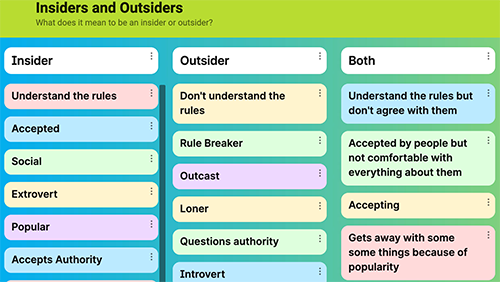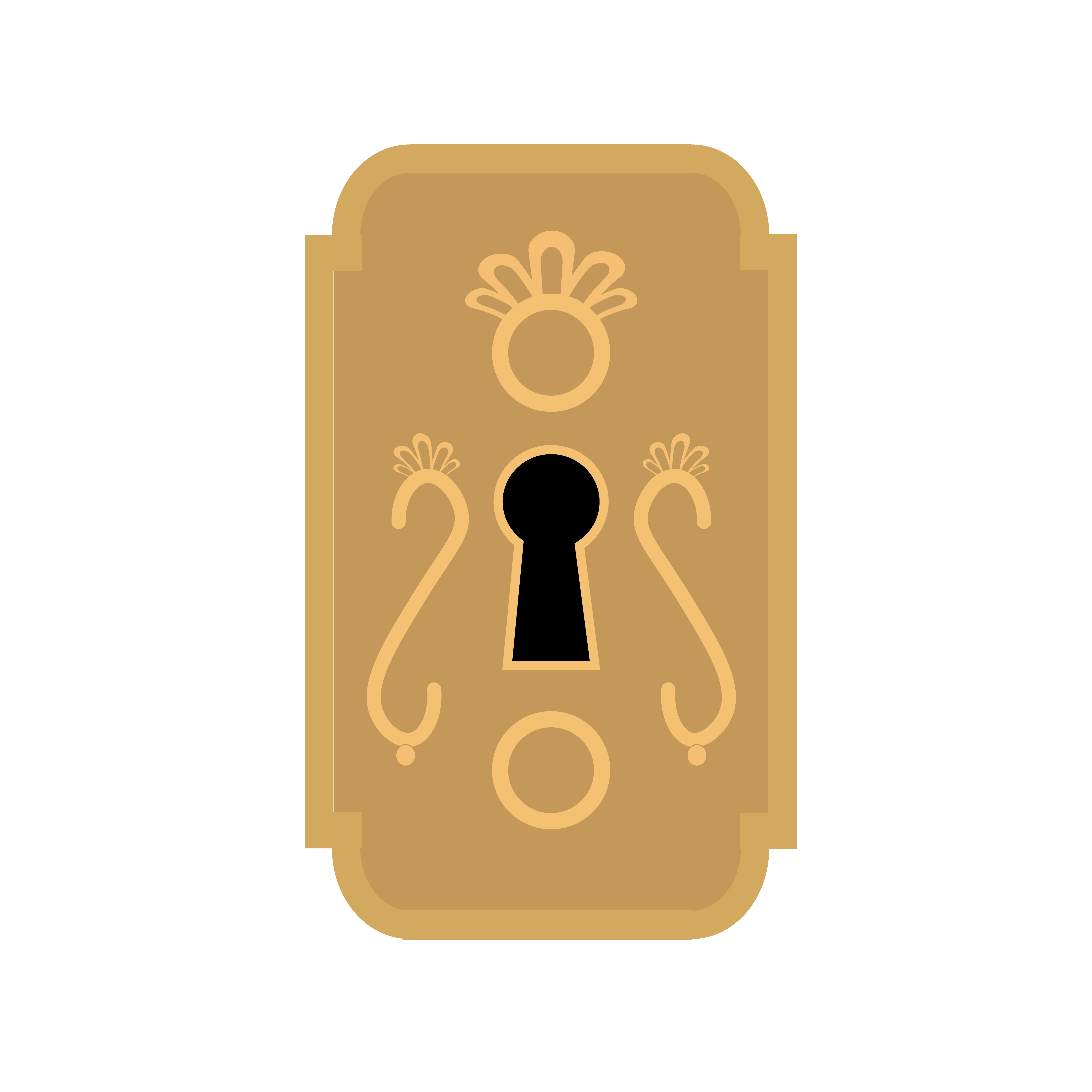Summary
In the interview with British Vogue, "Ask a Legend: Billie Eilish Answers Questions from Justin Bieber & 22 Other Famous Fans," singer-songwriter Billie Eilish said of her lyric writing process: “It’s good to know the basics of something because then you can take those basics and shift them around.” For many pieces of writing, like essays, an outline helps the writer plan and see the basics of their writing before making stylistic shifts. In this lesson, students practice writing an essay outline by collaboratively generating elements of an outline before applying the structure to their own writing.
Essential Question(s)
In what ways can a piece of writing be clear and purposeful for the reader?
Snapshot
This lesson can be taught alone or after the Let Us Start the Lettuce Club (Or Not) LEARN lesson as part of a writing series.
Engage
Students form an opinion on whether the singer Billie Eilish is an "insider" or an "outsider," based on an article headline.
Explore
Students complete a Two-Minute Paper on what it means to be an insider or outsider and consider whether or not someone can be both.
Explain
Students explore real-world applications for creating outlines and discuss the purpose of an outline.
Extend
Students explore options for outlines and collaboratively create an outline over a topic.
Evaluate
Students choose from one of three Exit Tickets that foster reflection on building a strong outline or writing a new outline for a specific writing task.
Materials
Internet access
Presentation technology
Student devices
Paper
Pencil or pen
Lesson Slides: Take Those Basics and Shift Them Around (attached)
"Billie Eilish: The Philosophy of an Outsider" (article, linked)
"Ask a Legend: Billie Eilish Answers Questions from Justin Bieber & 22 Other Famous Fans | British Vogue (interview, linked)
Engage
Slide 3 uses the title of an article published to medium.com in December 2019, titled "Billie Eilish: The Philosophy of an Outsider" and subtitled "How a mainstream artist is expressing what many of us feel deep down in our darkest moments." Students do not need to read the article for this activity, but it is linked here for your reference.
Ask students to share their initial thoughts about the headline. Would they consider Billie Eilish an "insider" or an "outsider"? Why?
Show slide 4, which includes the subtitle. Ask students to explain their perceptions of the title. Ask them whether or not there is anything that seems contradictory about the word choice.
Explain to students that an essential part of a piece of writing is the author’s opinion. Explain that a claim is a statement that reflects the writer’s opinion on a topic. Advise them that a claim can most clearly explain a writer’s position when supported by credible and relevant evidence.
Show slide 5, which reflects the Essential Question: In what ways can a piece of writing be clear and purposeful for the reader?
Show slide 6, which outlines the lesson Objectives:
Define the essential points of a topic or question
Organize a logical flow of a topic’s claim and supporting subtopics that support the claim
Compose an outline that identifies the purpose and sequence of an introduction, thesis statement, body paragraphs, and conclusion
Explore
Show slide 7. Ask students to complete a Two-Minute Paper addressing the question: What does it mean to be an insider or an outsider?
Invite them to write about one or both terms. Have them write about either their personal experience or relate their claim to celebrities like Billie Eilish.
After two minutes, invite students to share their responses with an Elbow Partner and select one key point from their response.
After enough time has passed for students to share with their Elbow Partners, have them share their key points about what makes an insider or an outsider on a collaborative Padlet. Below is an image of how to set up this Padlet with sample student responses.

On the Padlet, there are two columns, one for "Insider" and one for "Outsider." Share the link or QR code with students and ask them to share their key points in the appropriate column.
If you opt not to use a Padlet, show slide 8 as a model for student responses.
After reviewing the list of points regarding what it means to be an insider or an outsider, introduce a new question: Can someone be both an insider AND an outsider at the same time?
Have students return to their Two-Minute Papers, respond to the new question, and share their key points with their same Elbow Partners.
While students share responses to this new question, add a new column labeled "Both" to the Padlet to collect these new points. These responses can be recorded on Slide 9.
There should now be three columns in response to the question, "What does it mean to be an insider or an outsider?" (1) Insider; (2) Outsider; (3) Both.
At this point in the lesson, students have defined some essential parts of the topic and questions that have been posed. Next, they will work toward organizing a logical flow of a claim, supporting subtopics that support the claim, and writing a conclusion.
Explain
Revisit the question, "What does it mean to be an insider or an outsider?" Ask students to choose a stance based on the feedback available on the Padlet.
Have students look over the three columns. (You can fill out the three columns on slide 10 with Padlet feedback).
Explain that as a class they have been working toward defining the essential points of a topic or question. This analysis is a first step in developing a stance or argument. Remind them that not everyone will agree with whether or not Billie Eilish was an outsider or an insider, so stances on a topic like that one or others will generally vary.
Show slide 11 to revisit the Essential Question: How can a piece of writing be clear and purposeful for a reader?
Ask students to respond to this question. Expand the discussion to explore the question: What does a writer need in particular to start a piece of writing with a clear, focused purpose? What about a clear, focused structure?
Though not guaranteed, it's likely that students will mention outlines.
Show slide 12. Introduce how an outline fits into a piece of writing by showing the Roadmap to Writing graphic. Let students show you where on the Roadmap to Writing graphic they see "Outline" represented. Ask them to explain why it makes sense to have this process here.
Reiterate that outlines are a useful and essential tool to start a piece of writing. Tell students that there are some real-world ways that people use outlines and that they aren't just for essays written in class.
Show slide 13 as a visual metaphor for an outline in a real-world context. This slide shows a page of music. Ask them to imagine how a page of sheet music might help someone like Billie Eilish write lyrics.
Segue to the excerpt from "Ask a Legend: Billie Eilish Answers Questions from Justin Bieber & 22 Other Famous Fans," the British Vogue interview on the Edpuzzle.
Ask students to discuss what they noticed about Eilish's view on planning for her creative process.
Extend
Slides 14, 15, and 16 illustrate three different ways to show students how outlines are written. Each outline has space for an introduction, three supporting subtopics, and a conclusion. These outlines are suitable for a 5-paragraph essay.
Slide 14 shows the classic "hamburger outline." This outline is helpful for visual learners.
Slide 15 shows a traditional outline that uses a system of Roman numerals. This outline is helpful for students who appreciate a detailed, linear format.
Slide 16 shows an outline made in Google Slides. This outline is helpful for students who think kinesthetically, as the slides can be moved around as students find their flow of ideas. Tell students that these formats are not exhaustive, but they are good places to start when choosing how to write an outline.
Students may wonder what goes where in an outline? The following link makes a forced copy of the Writing an Outline Google Slide so each student or group of students can have their own copy. Have students explore and play in this slide to practice thinking through an outline where an introduction, supporting subtopics, and a conclusion would go. If you want students to turn in this activity, they can take a screenshot or add you to their Google Slide.
Give students time to sort the virtual sticky notes on their slide to the corresponding section of the outline. As they are moving the notes to the appropriate places, ask students to make a note of the following:
What words in particular helped you organize the sticky notes?
What pattern(s) do you see in this outline that are similar in other outlines?
Once enough time has passed so that everyone has had sufficient time to address the questions, ask students to discuss their responses with the whole class. Students will likely share that the words that helped them organize the sticky notes were the words like "first," "furthermore," and "ultimately."
If transition words have not already been introduced, this is a good time to identify this topic and address transitions in a mini lesson. Students will likely notice that patterns emerge, such as that an outline starts with an introduction, subtopics follow, and closes with a conclusion. They may point out the thesis statement from the Writing an Outline Google Slide about walking cats in this activity.
Have students practice by applying this structure to a topic of their own choosing.
Evaluate
The evaluation for this lesson can be modified to fit the appropriateness of students applying the outlines written in this lesson or the need to take what was learned and apply it to a new outline. The options below cover a range of needs:
Exit Ticket: If you do not have an upcoming research paper, consider why an outline is an important initial step when launching creative expression. Ask students to submit their tips for writing a strong outline. These tips can be grouped according to themes and used for an anchor chart, or to see what "clicked" with students and what information needs to be revisited.
Exit Ticket: If you have an upcoming research paper or essay assignment planned for after teaching this lesson, consider have students compose an outline based on their stance about a topic you provide.
Exit Ticket: If you want to continue the theme from this lesson, introduce that the essay prompt examines insiders and outsiders (stereotypes and how those lines are gray areas or dispelled). Have students draft an outline.
Resources
British Vogue. (2021, May 3). Billie Eilish answers questions from Justin Bieber & 22 other famous fans. [Video]. Youtube.
Edpuzzle. Billie Eilish answers questions from Justin Bieber & 22 other famous fans. [Video]. https://edpuzzle.com/media/609ffffc74b39b417874fa47
K20 Center. (n.d.) Bell Ringers and Exit Tickets. Strategies. https://learn.k20center.ou.edu/strategy/125
K20 Center. (n.d.). Edpuzzle. Tech Tools. https://learn.k20center.ou.edu/tech-tool/622
K20 Center. (n.d.) Elbow Partners. Strategies. https://learn.k20center.ou.edu/strategy/116
K20 Center. (2022). Let us start the Lettuce Club (or Not). LEARN. https://learn.k20center.ou.edu/lesson/1737
K20 Center. (n.d.). Padlet. Tech Tools. https://learn.k20center.ou.edu/tech-tool/1077
K20 Center. (n.d.) Two-Minute Paper. Strategies. https://learn.k20center.ou.edu/strategy/152
Vasilachi, Andrei. (2019, December 11). Billie Eilish: The philosophy of an outsider. Medium. https://medium.com/@avasilachi/billie-eilish-the-philosophy-of-an-outsider-4eebed80a588



